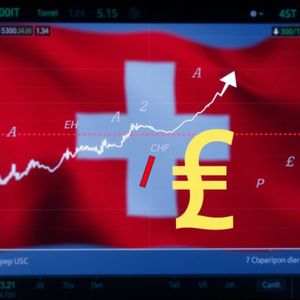BitcoinWorld Swiss Franc’s Unprecedented Strength: UBS Slashes EUR/CHF Targets Amidst Market Turmoil In the dynamic world of global finance, where even the most stable assets can experience unexpected shifts, the recent actions by UBS regarding the Swiss Franc have sent ripples through currency markets. For those keenly observing the interplay between traditional finance and the nascent cryptocurrency space, understanding these macroeconomic shifts is crucial. A stronger Franc, for instance, can influence capital flows and even impact the perceived stability of fiat-backed stablecoins. UBS, a financial giant, has dramatically cut its EUR/CHF targets, signaling a significant recalibration of expectations for one of the world’s most watched currency pairs. This move highlights how traditional patterns are being challenged, forcing investors and traders to rethink their strategies. Why is the Swiss Franc Defying Expectations? The Swiss Franc has long been celebrated as a quintessential safe-haven currency, a reliable refuge during times of global economic uncertainty. Its strength is typically tied to Switzerland’s robust economy, political neutrality, and a strong current account surplus. However, its recent performance has gone beyond traditional safe-haven flows, exhibiting an unprecedented resilience that has caught many analysts off guard. Several factors contribute to this phenomenon: Aggressive Monetary Policy: The Swiss National Bank (SNB) has been proactive in its fight against inflation, implementing interest rate hikes that have made the Franc more attractive to yield-seeking investors. This hawkish stance contrasts with some other central banks, providing a relative advantage. Persistent Inflationary Pressures: While inflation in Switzerland might be lower than in some other major economies, the SNB’s commitment to price stability reinforces confidence in the Franc’s purchasing power. Global Economic Uncertainty: Geopolitical tensions, energy crises, and lingering supply chain issues continue to fuel demand for perceived safe assets, and the Franc fits this bill perfectly. However, its current strength suggests more than just a flight to safety; it indicates a fundamental re-evaluation of its value. Reduced SNB Intervention: Historically, the SNB has intervened to prevent excessive Franc appreciation. Recent periods have seen less direct intervention, allowing market forces to push the currency higher. This confluence of factors has created a unique environment where the Franc’s strength is not just a temporary reaction but potentially a sustained trend, challenging long-held assumptions about its equilibrium. The Dramatic Shift in EUR/CHF Targets: What Does it Mean? The EUR/CHF currency pair represents the exchange rate between the Euro and the Swiss Franc. A lower EUR/CHF value means it takes fewer Euros to buy one Swiss Franc, indicating a stronger Franc. UBS’s decision to slash its targets for this pair is a powerful statement about the Franc’s enduring strength and the Euro’s relative weakness. Previously, many analysts expected the EUR/CHF to stabilize or even recover, but UBS’s revised outlook suggests a more prolonged period of Franc dominance. This target cut signifies several key implications: Confirmation of Franc’s Strength: It validates the market’s current assessment that the Swiss Franc is fundamentally strong and likely to remain so for the foreseeable future. Euro’s Headwinds: It underscores the challenges facing the Eurozone, including persistent inflation, slower economic growth, and the European Central Bank’s (ECB) potentially less aggressive monetary tightening compared to the SNB. Impact on Trade: A stronger Franc makes Swiss exports more expensive and imports cheaper, affecting Switzerland’s trade balance. Conversely, it makes Eurozone goods cheaper for Swiss consumers but Eurozone exports to Switzerland less competitive. Investor Sentiment: Such a significant revision from a major bank can influence broader market sentiment, potentially encouraging other institutions to follow suit and adjust their own forecasts. The move by UBS is not just an adjustment of numbers; it reflects a fundamental shift in the underlying economic and monetary dynamics impacting these two crucial European currencies. Unpacking the UBS Forecast : A Deeper Dive into Analyst Perspectives The latest UBS forecast represents a significant recalibration of expectations for the EUR/CHF pair. While specific figures can vary, the essence of their revised outlook points towards a lower equilibrium for the pair than previously anticipated. This isn’t merely a tactical adjustment; it’s a strategic reassessment based on evolving macroeconomic realities. UBS’s rationale often includes: Divergent Monetary Policies: The SNB’s commitment to combating inflation through rate hikes, often ahead of the ECB, creates a yield differential favoring the Franc. Inflationary Differentials: While both regions face inflation, the relative success of the SNB in managing it, or at least its perceived commitment, boosts the Franc’s appeal. Economic Resilience: Switzerland’s economy has shown remarkable resilience despite global headwinds, supporting its currency. Geopolitical Risk Premium: The Franc continues to benefit from its safe-haven status, with global uncertainties acting as a constant tailwind. To illustrate the magnitude of these adjustments, consider a hypothetical comparison of UBS’s old versus new targets: Time Horizon Previous EUR/CHF Target (e.g., Q3 2023) New EUR/CHF Target (e.g., Q3 2023) Change 3 Months 0.9900 0.9650 -2.52% 6 Months 0.9850 0.9500 -3.55% 12 Months 0.9800 0.9400 -4.08% (Note: These figures are illustrative and reflect the general direction of a target cut.) This table highlights a consistent downward revision across various timeframes, indicating a fundamental belief in the Franc’s sustained strength. Such a definitive stance from a leading financial institution can have a cascading effect, influencing other market participants and potentially accelerating the trend. Navigating Volatile Currency Markets : Challenges and Opportunities The current environment, characterized by a surging Swiss Franc and shifting central bank policies, presents both significant challenges and unique opportunities across global currency markets . For businesses, investors, and even everyday consumers, understanding these dynamics is paramount. Challenges: Increased Volatility: Unpredictable shifts in currency values make it harder for businesses to plan and budget, especially those engaged in international trade. Hedging Costs: Companies with exposure to the Franc might face higher costs to hedge against currency fluctuations, impacting profit margins. Investment Risk: Investors holding Euro-denominated assets or those exposed to Eurozone economies face currency depreciation risk if the EUR/CHF continues to fall. Economic Competitiveness: For Eurozone exporters, a weaker Euro against the Franc can make their goods cheaper in Switzerland but overall competitiveness can be affected by other factors. For Swiss exporters, a strong Franc makes their products more expensive internationally. Opportunities: Purchasing Power: For Swiss consumers and businesses, a stronger Franc means imported goods and services from the Eurozone become cheaper. Investment in Franc-denominated Assets: Investors seeking safe havens or capital appreciation might find Swiss bonds or other Franc-denominated assets more attractive. Arbitrage and Speculation: Experienced traders can leverage the volatility and divergent central bank policies for potential profit through strategic forex trading. Diversification: A strong Franc offers an opportunity for portfolio diversification, especially for those seeking to reduce exposure to other major currencies facing headwinds. These market conditions demand a proactive approach, with continuous monitoring of economic indicators, central bank communications, and geopolitical developments. Actionable Insights for Forex Trading Amidst Franc’s Strength For those involved in forex trading , the strengthening Swiss Franc and UBS’s revised targets offer critical insights and potential strategies. Navigating this environment requires a blend of fundamental and technical analysis, coupled with robust risk management. Key Considerations for Traders: Follow Central Bank Signals: Pay close attention to communications from the SNB and the ECB. The SNB’s continued hawkish stance or any signs of intervention will be crucial. Similarly, any unexpected shifts from the ECB could impact the EUR’s trajectory. Monitor Economic Data: Keep an eye on inflation figures, GDP growth, and employment data from both Switzerland and the Eurozone. Strong Swiss data reinforces Franc strength, while weak Eurozone data exacerbates Euro weakness. Technical Analysis: Use technical indicators to identify potential support and resistance levels for the EUR/CHF pair. A strong downtrend suggests further downside, but watch for signs of oversold conditions or potential reversals. Risk Management is Paramount: Given the volatility, always use stop-loss orders to limit potential losses. Avoid over-leveraging, especially when market sentiment is strong in one direction. Consider Carry Trades (with caution): While the SNB has raised rates, the interest rate differential might still be favorable for holding Francs against lower-yielding currencies. However, carry trades come with inherent risks if the exchange rate moves unfavorably. Diversify Exposure: Don’t put all your eggs in one basket. If you’re trading the EUR/CHF, consider balancing your portfolio with other currency pairs or asset classes to mitigate risk. Long-Term vs. Short-Term: Assess whether your trading strategy aligns with the perceived long-term strength of the Franc or if you’re looking for short-term tactical plays on volatility. UBS’s forecast suggests a longer-term trend. Understanding the interplay of these factors will enable traders to make more informed decisions in a market that continues to defy conventional wisdom. A Resilient Franc in an Unpredictable World The decision by UBS to cut its EUR/CHF targets is a powerful indicator of the Swiss Franc’s remarkable and perhaps unprecedented strength. This move underscores a significant shift in global currency markets , where traditional patterns are being challenged by aggressive monetary policies, persistent inflation, and geopolitical uncertainties. The implications for the EUR/CHF pair are profound, signaling a sustained period of Franc dominance. For investors and those engaged in forex trading , the UBS forecast serves as a critical guide, emphasizing the need for adaptable strategies, robust risk management, and a keen eye on evolving macroeconomic landscapes. As the world navigates an era of economic unpredictability, the Swiss Franc stands out as a beacon of resilience, forcing a re-evaluation of established norms and offering both challenges and opportunities for the astute market participant. To learn more about the latest Forex market trends, explore our article on key developments shaping global currency valuations and institutional adoption. This post Swiss Franc’s Unprecedented Strength: UBS Slashes EUR/CHF Targets Amidst Market Turmoil first appeared on BitcoinWorld .
 200 Million XRP Shocks the XRP Army
200 Million XRP Shocks the XRP Army New Ways Young Londoners Relax Today
New Ways Young Londoners Relax Today











